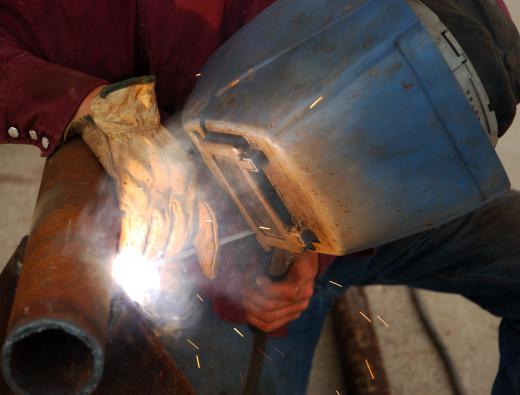At AboutMechanics, we're committed to delivering accurate, trustworthy information. Our expert-authored content is rigorously fact-checked and sourced from credible authorities. Discover how we uphold the highest standards in providing you with reliable knowledge.
What is a Spot Welder?
A spot welder is a device that uses an electrical current to fuse two pieces of metal together. These typically operate by using a transformer and a large capacitor to build up a large electrical charge. The charge can then flow from one electrode of the spot welder, through the pieces of metal that are clamped together by the electrodes, and into the other electrode. The electrical resistance of the pieces of metal can create a temperature that is high enough to weld them together. This creates a spot weld, which is literally a spot on each piece of metal that is welded to the other.
The theory behind the spot welder, directing current through pieces of metal, is a relatively simple one. Spot welding can actually be achieved by even a simple homemade device consisting of a power source, transformer, and electrodes. Commercial spot welders will tend to be more complex, though, with controls to change the amount of current and the duration of the weld. Some will also include a feature known as a double pulse. This involves an initial pulse of current to soften the metals, after which the electrodes will clamp down tighter to get a stronger weld during a second pulse.

Spot welding is generally used to join relatively thin pieces of metal that range in thickness between 0.02 and 0.12 inches (0.5 to 3 mm). The amplitude of the current and length of the process can often be modulated, allowing one spot welder to join materials of different thicknesses and compositions. The correct amplitude and duration will lead to a strong bond between the pieces, while either extreme will result in an unsatisfactory join. Too short a weld with too little heat and the bond will be weak, while too much heat can simply burn a hole through the pieces of metal.
It may be possible to join thicker pieces of metal with a spot welder using a process known as projection welding. This variation of spot welding uses projections on the pieces to be joined, and involves directing heat to those specific points. This can allow thicker pieces to be joined without damaging the metal. It may also be used to weld things like bolts or other thick, or unusual, materials. At the extreme ends, some spot welders may be able to weld materials as thin as 0.008 inches (0.2032 mm) or as thick as 1.25 inches (31.75 mm).
AS FEATURED ON:
AS FEATURED ON:











Discussion Comments
Spot welding is a very important process, so it is important to select the proper electrode material to get the best result. Thanks for sharing this wonderful article and links. It will help everyone to get a good idea of the prices and brands.
Post your comments